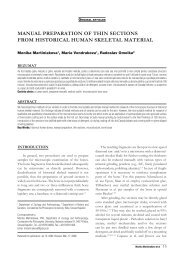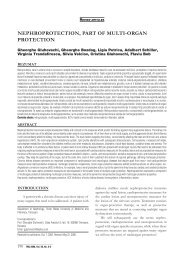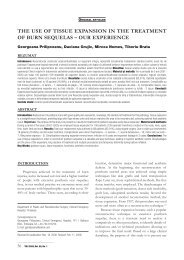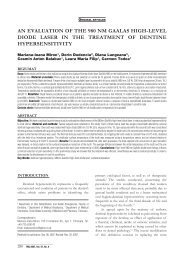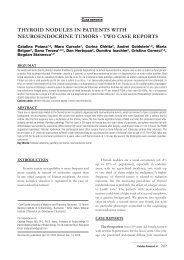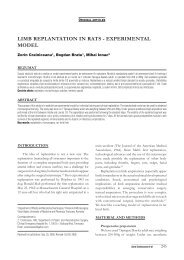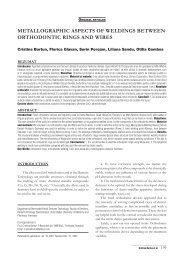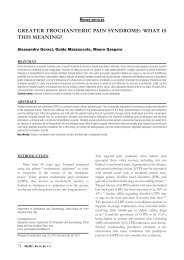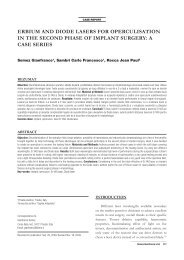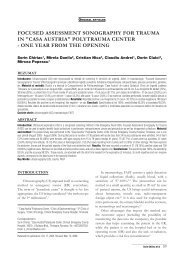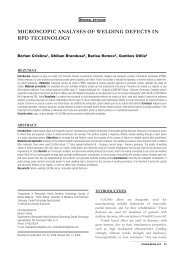endoscopic-assisted harvest of pedicled and free latissimus dorsi ...
endoscopic-assisted harvest of pedicled and free latissimus dorsi ...
endoscopic-assisted harvest of pedicled and free latissimus dorsi ...
Create successful ePaper yourself
Turn your PDF publications into a flip-book with our unique Google optimized e-Paper software.
comitant vein when inserting the retractor (2 cases);<br />
in group 2, one comitant vein injury during pedicle<br />
dissection (two cases). The bleeding was controlled<br />
<strong>and</strong> injured vein clipped. The cases with VC injury<br />
were deliberately included in follow-up group.<br />
First day postoperatively, all animals resumed<br />
ambulation <strong>and</strong> feeding habits, minimal functional<br />
impairment was noticed for 1-2 days postoperatively.<br />
Near the origin <strong>of</strong> LD muscle, small ecchymosis (two<br />
cases) was noticed first day postoperatively that slightly<br />
enlarged for the next 2 days; however, when donorsite<br />
reopened at 1 week, there is no fresh bleeding at<br />
inspection <strong>and</strong> no hematomas. (Fig. 7)<br />
In five cases, non-infected seromas were found<br />
<strong>and</strong> evacuated. All muscles were viable after 30 minutes<br />
observation <strong>and</strong> after 1 week follow-up.<br />
Muscles lengths ranged from 13/10 cm to 16/13<br />
cm on the back table. (Fig. 8)<br />
Figure 7. Ecchymosis at 1 week after LD <strong>endoscopic</strong>-<strong>assisted</strong> <strong>harvest</strong>.<br />
Figure 8. Endoscopic-<strong>assisted</strong> <strong>harvest</strong>ed LD muscle <strong>free</strong> flap.<br />
DISCUSSION<br />
The LD is a workhorse for selected reconstructive<br />
surgeries due to its versatility. It is successfully used,<br />
either as a <strong>pedicled</strong> or <strong>free</strong> flap, in breast, chest wall,<br />
spinal, head <strong>and</strong> neck, lower limb reconstruction <strong>and</strong><br />
scalp resurfacing. Large incisions make the muscle<br />
_____________________________<br />
150 TMJ 2010, Vol. 60, No. 2 - 3<br />
<strong>harvest</strong>ing straightforward but leaves conspicuous<br />
scars, decreasing patient satisfaction in the face <strong>of</strong><br />
otherwise excellent reconstructive results. 1-7<br />
Since the early ‘90s, <strong>endoscopic</strong>-<strong>assisted</strong><br />
<strong>harvest</strong>ing <strong>of</strong> LD muscle achieved shorter incisions<br />
with less postoperative discomfort or pain, earlier<br />
recovery from surgery <strong>and</strong> less expensive wound care;<br />
edema, ecchymosis, seromas <strong>and</strong> infection rates were<br />
not decreased in all studies. 8-30 The advantages have<br />
encouraged surgeons to use the <strong>endoscopic</strong> method<br />
but the reports are still scarce <strong>and</strong> have not gained the<br />
same popularity within plastic surgery as it has in other<br />
surgical specialties. The main hurdle is the additional<br />
learning curve for <strong>endoscopic</strong> techniques; training<br />
models <strong>and</strong> fewer opportunities when compared to<br />
laparoscopy or arthroscopy. 39,40<br />
The swine model <strong>of</strong> muscle myocutaneous LD was<br />
described initially as an excellent model for research<br />
in physiological, pathological <strong>and</strong> pharmacological<br />
experiments. Later the similarities to human anatomy,<br />
favorable position (quickly <strong>and</strong> easily elevated) <strong>and</strong><br />
large, accessible vascular pedicle made it an excellent<br />
model for training <strong>of</strong> the surgical skills. This too has<br />
been our experience. 31-37<br />
The aim <strong>of</strong> this study was to evaluate the<br />
<strong>endoscopic</strong>-<strong>assisted</strong> LD <strong>harvest</strong>ing model in swine.<br />
Two consecutive animal groups underwent the LD<br />
<strong>harvest</strong>ing as <strong>pedicled</strong> <strong>and</strong> <strong>free</strong> flap, respectively.<br />
For all cases, each muscle was <strong>harvest</strong>ed through<br />
single skin incision <strong>of</strong> 4-5 cm, adequate to comfortably<br />
accommodate the instruments (endoscope, retractor,<br />
forceps <strong>and</strong> electrocautery/scissor) <strong>and</strong> to retrieve the<br />
muscle. 41 As Lin et al. advocate, if muscle size is smaller<br />
than 20 cm, an additional incision is unnecessary. 17<br />
Adherent fibr<strong>of</strong>atty tissue overlaying the muscle is<br />
cut first, using electrocautery; if the undersurface is<br />
dissected first, muscle contraction during outersurface<br />
dissection would be too strong, increasing the chances<br />
for tissue injury.<br />
Anatomical <strong>and</strong> technical constraints need to be<br />
overcome for successful operation. Rigid <strong>endoscopic</strong><br />
instruments accommodate poorly to the rigid <strong>and</strong><br />
convex chest wall. 12 Even if the instrument length<br />
is adequate for the optical cavity length, the straight<br />
instruments are not adapted to the three-dimensional<br />
cavity requirements. Increased difficulty is encountered<br />
in the areas most distant from the incision. 40,41 For<br />
the first two cases, bleeding from intercostal artery<br />
perforators was ineffectively addressed, also due to<br />
inexperience in using irrigation-suction device; cases<br />
were converted to classic <strong>harvest</strong> <strong>and</strong> excluded from<br />
the study. For later cases, the use <strong>of</strong> long curved<br />
electrocautery achieved better hemostasis <strong>and</strong> a 30



